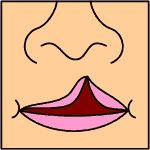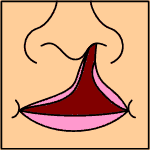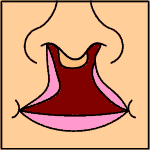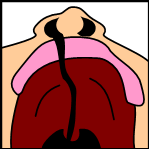Definition
A cleft is a birth defect that occurs when the tissues of the lip and/or palate of a fetus do not properly fuse very early in the pregnancy. A cleft lip, sometimes referred to as a harelip, is an elongated opening between the upper lip and the nose. It may involve one or both sides of the lip and may occur with or without a cleft palate. A cleft palate, in which the roof of the mouth abnormally opens into the floor of the nose, may also occur without a cleft lip.
Description
One of every 30 babies is born with some type of birth defect. Approximately one in 700 has a cleft, the fourth most common birth defect in the United States (congenital heart defect is the most prevalent). Twice as many boys as girls are afflicted with a cleft lip, both with and without a cleft palate. However, twice as many girls as boys are afflicted with a cleft palate without a cleft lip. Clefting occurs most often in Asians, Latinos, and Native Americans (one of 500 births) and least often in people of African descent (one of 1000 births).
Babies born with cleft lips or cleft palates may have trouble breathing, as well as swallowing. They cannot adequately suck, so they cannot nurse and must be fed with a special bottle or a bulbar syringe. Later, when their teeth erupt, the upper and lower teeth and jaws are often misaligned, resulting in difficulty chewing. Thus, clefting leaves children vulnerable to dehydration and malnutrition. A cleft palate also affects a child's speech, since the palate is necessary for speech formation. Even when a cleft palate is surgically repaired, it can permanently affect an individual's speech patterns.
Causes & symptoms
A cleft results when developing facial structures fail to fuse between the fourth and eighth weeks of gestation. This failure may be initiated by either genetic or environmental factors. The genes that cause clefting may be passed from either parent. A parent with a cleft has at least a 5% chance of passing along the trait. However, if the clefting is associated with a recognized genetic syndrome in which the genes are dominant rather than recessive, the chance of inheritance becomes 50%. Clefting may also result from environmental disruptions in development. These disruptions may be triggered by drugs, tobacco, or the rubella virus. The mother's diet during pregnancy may also affect the likelihood of clefting. This critical fusion stage takes place very early in the pregnancy, before many women even find out they are pregnant, so they may not yet have stopped using substances that may be harmful to the fetus or begun taking prenatal vitamins.
Diagnosis
Clefting is apparent upon examination immediately after birth. The extent of the deformity varies with the severity of the cleft lip or palate.
Treatment
Clefts may be repaired with reconstructive surgery that closes the palate and returns the lip to its normal position. Cleft lip defects may be repaired shortly after birth, but many doctors prefer to operate on infants according to the "rule of 10": when the child is at least 10 weeks old and weighs at least 10 pounds. While repair of the cleft lip is usually successful in one operation, a second operation may be performed later to refine the scar. Repair of a cleft palate is performed in a series of operations not usually completed by the time the child is two years old. If the defect lies primarily in the forward, bony portion of the palate (called the hard palate), doctors may wait to operate until the child is between five and seven years old and has more bone growth.
Nonsurgical treatment of a cleft palate is available for patients who do not want surgery or who are at high risk in surgery. One option is a prosthetic appliance worn as an artificial palate.
Later, the child will need orthodontic treatment to realign the structures of the mouth for proper function. The child may also need speech therapy to produce intelligible sounds with cleft-affected anatomy.
Children with clefts are also vulnerable to frequent ear infections. Their Eustachian tubes do not effectively drain fluid from the middle ear to the mouth, so fluid accumulates, pressure builds, and infection sets in. These children must have drainage tubes inserted into their ears to prevent hearing loss.
Children born with cleft lips and palates who become unduly self-conscious of their appearance and speech differences may benefit from psychological therapy. Parents who suffer guilt over their child's birth defect may also find help in professional counseling.
Prognosis
With reconstructive surgery, orthodontic treatment, and speech therapy, the effects of clefting may be minimized. Breathing, eating, adn speech are also greatly improved with treatment. With the anatomical structures corrected and their functions restored, a child born with a cleft lip and/or palate may lead a normal life.
Prevention
No known means of preventing clefting in a developing baby is known, although early pregnancy detection and good prenatal care, including prenatal vitamins and the avoidance of harmful substances appear to reduce the risk. Couples with an incidence of clefting in their families may wish to consult a genetic counselor.
Key Terms
- Cleft
- A gap or elongated opening that occurs when tissues do not properly fuse during prenatal development.
- Fuse
- To grow together into one coherent structure. Adjacent body parts may fuse as part of normal development or under conditions of abnormal development.
- Palate
- The structure that forms the roof of the mouth, separating the oral cavity from the nasal cavity. The bony front (anterior) portion is called the hard palate and the fleshy rear (posterior) portion is called the soft palate.
Further Reading
For Your Information
Books
- Johnson, Sylvia, et al. A Parent's Guide to Cleft Lip and Palate. Minneapolis: University of Minnesota Press, 1990.
- Kernahan, Desmond A. And Sheldon Rosenstein. Cleft Lip and Palate: A System of Management. Baltimore: Williams and Wilkins, 1989.
Organizations
- American Cleft Palate - Craniofacial Association and Cleft Palate Foundation. 1829 East Franklin Street, Suite 1022, Chapel Hill, NC 27514. (919) 933-9044. (800) 24-CLEFT. http://www.cleft.com.
- Cleft Palate - Craniofacial Center, University of Pittsburgh School of Dental Medicine. Pittsburgh, PA. (800)408-7390 or (412) 648-8779. http://www.cpc.pitt.edu.
- Cleft Palate Foundation. 1218 Grandview Avenue, Pittsburgh, PA 15211. (800) 24-CLEFT. http://www.cleft.com.
- Wide Smiles Inc. P.O. Box 5153, Stockton, CA 95205-0153. http://www.widesmiles.org.
Gale Encyclopedia of Medicine. Gale Research, 1999.





